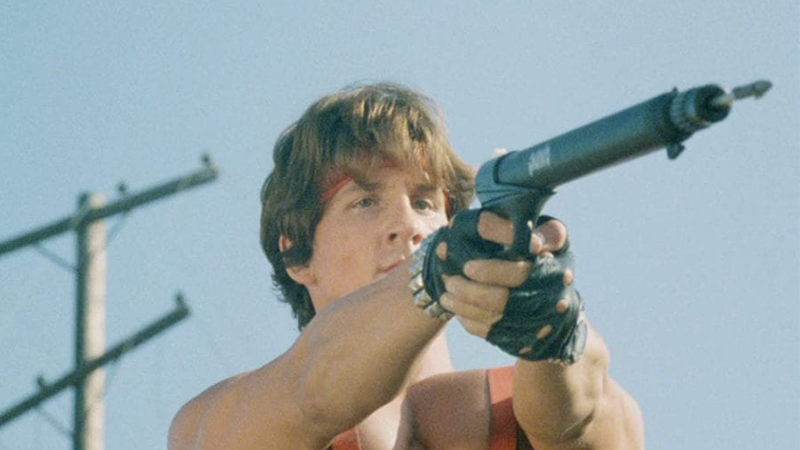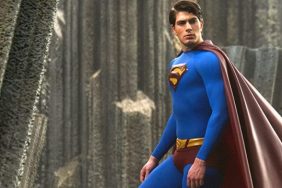In 1987, there was one law of the land — a strict commandment everyone who touched the sand lived by.
“Who rules the beaches?”
“Surfers.”
“And who rules the surfers?”
“Surf Nazis!”
An earthquake has rocked California and devastated most of the coastline, killing many residents and displacing others. The beaches are in a state of anarchy, but people still need to surf, which makes it ripe territory for gangs to fight over. The worst of these groups is called the Surf Nazis, led by Adolf (Barry Brenner), who has declared himself “Führer of the New Beach,” with his girl, Eva (Dawn Wildsmith), the crazed Mengele (Michael Sonye), as well as Hook (Joel Hile) and Brutus (Gene Mitchell), who all use a “bunker” as their base. They may have been able to rewrite history for the Reich on this new battleground, had they not run afoul of Eleanor “Mama” Washington (Gail Neely). Now the waves will run red with blood.
I remember first seeing this unsung classic on the show where the unloved greats all got second chances, USA Up All Night — and it was glorious. Surf Nazis Must Die is commonly referred to as a Troma film, or at least associated with the brand, but it was only distributed by them. The movie was made by a group called The Institute, and though the project was an exploitation film and leaned into the outrageous, it was a little more serious and grounded than the works that made Troma famous. There’s less gore, but a large helping of straight-laced craziness. The plot structure itself doesn’t go for a typical format, instead establishing the setting and characters, then taking an extended break to focus on the world around the titular Surf Nazis before truly starting its revenge premise.

If this sounds like B-movie schlock, that’s because it is. That doesn’t mean it isn’t worth noting, however. The film is set in a near-future that somehow feels far in the past and yet still right around the corner. The acting isn’t stellar, even if it is almost Shakespearian in how over-the-top it is at points, but there are a couple of good character moments and memorable scenes that are simply not followed up on or lingered in enough. The film is loosely based on the actual Surf Nazis of that culture, and can expose that part of the real history to those who know nothing about it, much like myself while researching this. Lloyd Kaufman, the co-founder of Troma, even said in an interview that he thought the film was forward-thinking, featuring an overweight African American woman as its protagonist.
It’s quite easy to find criticism of Surf Nazis Must Die, and many reviewers aren’t fans of the film for understandable reasons. Reports even claim that Roger Ebert famously walked out of the movie after 30-minutes, while others have described it as having no redeeming features. To their credit, the pacing is erratic, there are several minor continuity errors, and some of the shock value doesn’t translate to metaphor or satire well — especially with some of the language used — but the film is also a victim of its own hype. Could this feature have ever possibly lived up to that excellent title or spectacular poster? The one thing that some people say about it, which I must wholeheartedly disagree with, is that this wonderful piece of 80s counter-culture is dull or uninteresting.
Surf Nazis Must Die has a lot going for it in the brisk 83-minutes in which it takes over the screen. From the start, viewers will notice the astounding soundtrack by Jon McCallum, which helps fuel the world the surfers have taken over – lawless and more isolated – filled with violence, sex, servitude, and some engaging graffiti. The acting is overly theatrical, where Adolph and Mama Washington control most of their scenes but sometimes feel like tiny figures on makeshift stages bumping into the next plot point. None of the actors are too recognizable outside of the B-movie pool, but most have several credits under their belts. There are also a few excellent practical effects and shots that show a few talented people were trying to do something more unique.

As for the surfing itself, all of that footage looks fantastic. The crew supposedly hired a camera unit just for these shots in particular but seemingly didn’t have the ability to do any stunts out on the waves. This meant that most of the fighting would have to take place on the beaches or concrete, leaving the surfing segments looking solid, but also acting more as interludes than anything important. Many will accuse the movie of having several disposable scenes and characters, but most of those moments act as world-building or to show how others fear the Surf Nazis. Even if they aren’t important to the overall plot, they still provide something, whereas the surfing is just there to look pristine.
It’s a Troma tragedy, a campy revenge film with some excellent quotes, and several tongue-in-cheek interactions that are hard not to smile at — flaws and all. Though Surf Nazis Must Die wasn’t received well upon its release, the movie seems to be more appreciated now and certainly has its fans. The company hasn’t forgotten it either, as there was a recent Blu-Ray release and it can be viewed on several streaming platforms, but the real story seems to be how proud the company was to bring it to audiences. Troma knew they had something that would be viable for years to come.
A former Troma employee, Chace Ambrose, told me how in the early aughts he attended a convention in Orlando, where Lloyd Kaufman had Ambrose dress in a Nazi uniform and chase him around the show floor yelling German-sounding gibberish into a megaphone to help promote the film. Ambrose said that people took notice, and there were only a handful of complaints until they were getting ready to leave the con. This was when someone angrily came up and claimed that their grandfather had died in the Holocaust. Kaufman’s response was to tell the man that his grandfather had also passed away in Auschwitz, after getting drunk on Schnapps and falling out of the guard tower.










